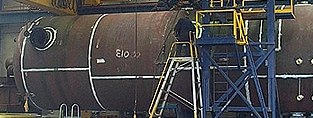
- (03) 5909 8218
- enquiry@fusionweld.com.au
The Importance of in Service Inspections for Pressurised Vessels
November 4, 2016

Controlled environments create predictable variables, which is something that truly benefits an engineering-oriented test scenario. Everything works predictably or overloads on cue. But wait, we're missing an obvious reality here. That's right, pressurized vessels aren't built to live in the facility where they were manufactured. These designs are manufactured as part of a system, a fluid infrastructure, so they require in service testing if they're to operate according to that system's limitations. That's one explanation for this important on-site practice, but there are others.
Analysed After Modifications and Major Repairs
Natural effects don't enter this situation, for the vessel or integral system part has undergone a major repair. The repair or system alteration has likely been concluded efficiently, but there's no room for "likelihoods" in pressure vessel safety. The in service procedure, therefore, analyzes the design for problems after the alteration has been concluded. Perhaps the system needs to be re-rated due to loading changes, or it requires structural analysis due to an extensive alteration. Regardless of the alterations or repairs, the equipment needs to be inspected and appraised so that it can still be classed according to its design limitations.
Scheduled In Service Inspections
Due to hazard factors, a pressurized vessel requires curated documentation and logging. The service work is conducted on a schedule, so as to evaluate structural changes that have, in all probability, occurred over a predictable period of time. These changes are systemically and naturally induced. A transient pressure spike incurred by an unstable chemical state switch represents a systemic event. Conversely, external corrosive agents need to be factored in as potentially troublesome external influences. They require prompt and aggressive solutions. Again, without this degree of on-site diligence, the stressed fluid container could explode or leak its volatile contents, so the service must take account of all environmental and temporal issues on a case-by-case basis.
The AS/NZS 3788:2006 in service pressure vessel inspection codes safeguard the Australian environment and local populace. Similarly, there are ASME rules and other international standards that govern this essential practice. They advocate specialized analysis routines be conducted on stress-heavy containers in salty environs and on welded vessels in fuel storage fields, but they also extend this mandate to cover less well-known application areas. These include the dangerous boilers and heat exchangers that live in the basements of inhabited structures. Major repairs and alterations are more common in these instances, but systemic problems also represent a hazard potential.
Contact Details
Fusion - Weld Engineering Pty Ltd
ABN 98 068 987619
1865 Frankston Flinders Road,
Hastings, VIC 3915
Ph: (03) 5909 8218
Optimized by NetwizardSEO.com.au
Recent Posts
- Compressed Hydrogen Storage Vessels: Material Selection, Design & Australian Standards
- Welding QA/QC in Oil & Gas Pressure Vessel Fabrication – Ensuring Code Compliance
- AS1210 vs ASME VIII Pressure Vessel Code: Key Differences for Australian Projects
- Mitigating Hydrogen-Induced Cracking in Pressure Vessels: Engineering and Material Strategies
- Storage Tank Solutions Australia: Field-Erected, Prefabricated & Self-Bunded Explained
- Reducing Environmental Risks: Self-Bunded Tanks in Australian Oil & Gas Operations
- Precision in Production: How Pressure Vessels Are Manufactured for Industrial Safety
- Shell & Tube Heat Exchangers: Improve Thermal Control & Energy Recovery in Petrochemical & Pharmaceutical Plants
- In-Service Inspection for Compressed Air Receivers for Power Plant Shutdown Prevention
- Power Plant Pipe Spooling Fabrication – Get Rapid, Code-Compliant Spools Ready for Installation
- Field Erected Tanks: Safe, Reliable On-Site Fuel Storage Solutions in Australia
- Custom Pressure Vessel Fabrication for Flammable Gases
Posts 2025
- Compressed Hydrogen Storage Vessels: Material Selection, Design & Australian Standards
- Welding QA/QC in Oil & Gas Pressure Vessel Fabrication – Ensuring Code Compliance
- View all articles…
Posts 2024
- Large Process Vessels: Optimising the Design for Maximum Efficiency [2025]
- Pressure Equipment Management System Installation: Detect Equipment Faults Early
- View all articles…
Posts 2023
- Pressure Piping System Inspection: A Gift of Safety for the Holidays
- Deaerator Inspections by Fusion-Weld Engineering and How They Reduce System Downtime
- View all articles…
Posts 2022
- How Fusion Weld Keeps Up With AS-NZS ISO 9001:2008 Standard
- Boiler Equipment Safety Inspection During the Summer Season
- View all articles…
Posts 2021
- Avoid These Factors and Practices that Contribute to Sealing Damage in Pressure Vessels
- Do's And Don'ts Of Industrial Boiler Inspection And Maintenance From Fusion-Weld
- View all articles…
Posts 2020
- What are the Risks and Hazards Involved in Pressure Vessel Equipment?
- How to Know if Your Pressure Equipment Needs Repair or Replacement?
- View all articles…
Posts 2019
- Factors that Contribute to Pressure Vessel Failure
- Pressure Vessel Regulations in Australia: What are the Mandatory Requirements?
- View all articles…
Posts 2018
- Pros and Cons of Spherical vs. Cylindrical Pressure Vessels
- What are the Different Hazard Levels in Pressure Vessels?
- View all articles…
Posts 2017
- Transportable Pressure Vessels: The Importance of Inspection and Safety Checks
- Fracture Mechanics and Stress Analysis of Cracks in Pressure Vessels
- View all articles…
Posts 2016
Posts 2015
- What Are Deaerators & Feedwater Vessels?
- Precautions and Safety for Compressed Air Receiver Vessels
- View all articles…
Posts 2014
- Demonstrating In-process Inspection Procedures
- Static Grounding Practices and Standards
- View all articles…